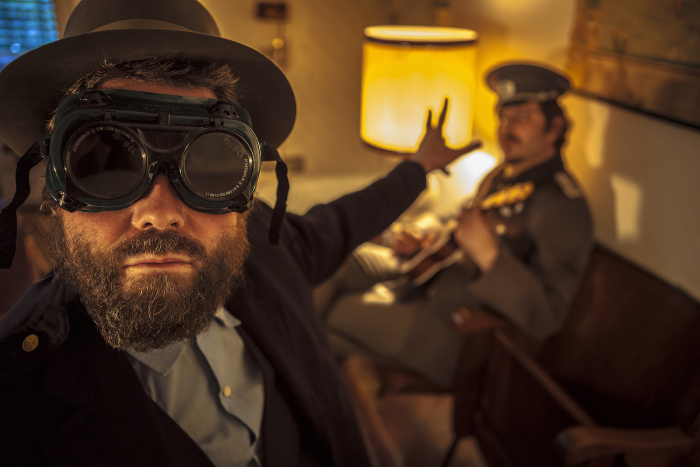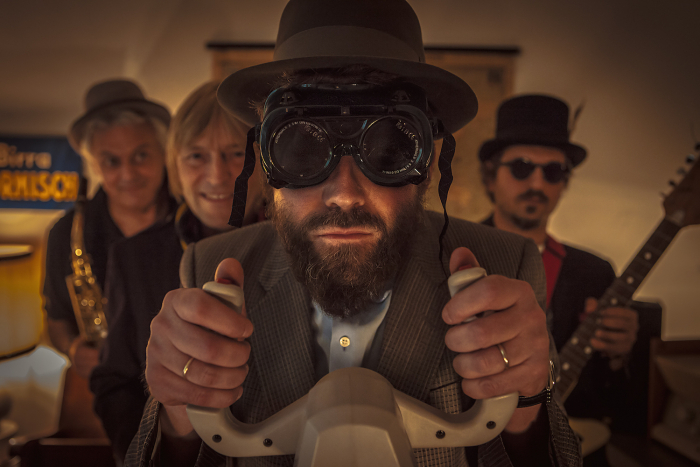When I was asked to write about “liscio” I immediately realized that this genre had never been explored, transformed, hybridized and reconsidered as much as in the last few years. And this thanks to people and bands like Enrico Gabrielli’s Orchestrina di Molto Agevole, Mirco Mariani’s Extraliscio, Mr. Zombie, Sacri Cuori Social Club and before them Elio e le Storie Tese with Raoul Casadei (only to name a few).
But let’s take this step by step.
Liscio (the Italian word for “smooth”, as the dancers seem to smoothly slide on the floor) is a musical genre and a social partner dance formalized in Romagna in the late nineteenth and the first decades of the twentieth century, mixing the mazurka/waltz/polka trio (originated in Central Europe in the XVIII and XIX century) with the first South American influences at the beginning of the XX century, the early jazz of the 1920s and the invention of “balere”, big ballrooms with bar service where you paid for each dance). Leading names in its history are: Carlo Brighi (concertmaster of Toscanini’s orchestra and also inventor of the first balera in 1910 in Bellaria), Secondo Casadei (the inventor of modern liscio) and his nephew Raoul Casadei.
In the last few years the most colourful and lively reinterpretation of liscio is with no doubt the Extraliscio project, conceived by songwriter Mirco Mariani (aka Saluti da Saturno and Vinicio Capossela’s long-time collaborator) in collaboration with liscio musicians Moreno Conficconi “Il Biondo” and Mauro Ferrara.
I meet Mirco Mariani in Bologna inside his Sancta Sanctorum, the Wunderkammer called Labotron, a studio/workshop hosting his collection of beautiful –and often forgotten– vintage instruments with bizarre names such as Mellotron, Memotron, Optigan, Ondioline, Clavioline, Dulcitone…
We immediately start talking about liscio, romagnolità and Romagna, Extraliscio and the album Canzoni da ballo released in February 2016.
There is no better person to inaugurate this column and try to analyse the state of the art of liscio today.
«My first band, back in the 1990s, was called Mazapegul, and I already called it a “show-orchestra”: as a true Romagnolo, I have always had a thing for liscio.
The first time I seriously started approaching liscio was when I was hosted with my project “Saluti da Saturno” on RAI Radio Due “Caterpillar” show and Paolo Maggioni told me: “I think you are the right person to revive liscio and Romagna’s music… I would like to talk about this and about you”. That was the spark!
After this unexpected event I met by chance Moreno Conficconi, clarinettist, band leader and charismatic character of the world of liscio. With him I also had the privilege to meet Riccarda Casadei, owner of Edizioni Casadei Sonora and daughter of the king of liscio Secondo Casadei.
But if we have to go even more back in time I still remember the summers when the leader of our community band drove me to Green Park in Cesenatico, where I used to play the drums in some liscio orchestras, and I didn’t want to go at a time when I just listened to the Weather Report and I was the only young person among older musicians in their sixties/seventies, whom today I remember as really generous towards music and their audience as well. Yes, this is something that stuck to me and that I would like to bring into my music.
When you carefully listen to liscio, when you plunge into it, you discover a rich world that is not easy to describe. Despite being strongly compromised with the market, liscio still has a powerful melancholic side, a mirage of the times when music still worked and meant something to people.
I have travelled a lot in Eastern Europe: Macedonia, Bulgaria, Albania, Romania. One of the first things that come to your mind here is music, music with a huge power. Now that I am deeply into Romagna’s folk music I can find a lot of similarities, since here liscio is a true, unbelievable kind of music, born from the earth, magic and infinite.
A liscio concert is first of all a show, a happening, and you never know how long it will last, as you keep on playing as long as people feel like dancing!
I see some similarities between circus and liscio in its more aerial, celestial side: Fellini! When you watch Fellini’s movies –and you concentrate on his powerful close-ups, on the faces…– you can find these same faces in the liscio “circus”, deep and powerful characters, peculiar and colourful, who populate fantastic, epic worlds.
Romagnolità, the character of those who come from Romagna. Romagnolità is made of cotton candy, tandems and paddle boats. Even if I come from the Apennines in Romagna (and not from the seaside), romagnolità to me means that kind of “everything or nothing at all” personality, being elegant yet kitschy, a braggart, a “sborone” as we call it here. It is something that I feel deeply inside myself even if, as I said, I come from the Apennines, where things are a little different.
As I told you before, the Extraliscio project was born from my accidental encounter with Riccarda Casadei and Moreno Conficconi. At the time, however, we didn’t know how things would have turned out.
It is not easy to gravitate around the world of liscio, since it is a musical genre with such a strong and well known personality that it’s all too easy to result in irony or parody.
My first approach was in the form of a song. And I decided to concentrate on the lyrics: tandems, cotton candy, paddle boats, words like: “the wind wipes memories from the sand / but from the heart it can’t / from the heart it can’t…”, words that really make you understand the essence of Cesenatico during the summer.
So far about the lyrics, and on the instrumental side a visceral proximity to the enthralling music from Eastern Europe.
So the words are the first aspect I decided to analyse: lyrics such as “Ciao mare” (“Bye bye sea”: The white sail is gone / in winter only seagulls remain / and the summer of my love / is now a faraway memory), “Riviera romagnola” (“Romagna’s Riviera”: Rimini, Cervia, Riccione, every place teaches you a song). “Il passatore”, for example, could have easily been interpreted by Fabrizio De André: “This is the sad story of Passator Cortese / who on the Lamone was betrayed and died. / Carried through the villages to be despised / some people cried, some other threw flowers”.
Finally I mixed all these aspects together, trying to keep away from that “karaoke” trend that seems to besiege the world of liscio these years (the painful compromise with the music industry I already mentioned).
In the future, Extraliscio is going to completely concentrate on the instrumental side. I would like liscio music to violently spread outside its birthplace, as it happened with the music from Eastern Europe or Spain or South America. To this purpose, I tried to take a snapshot, to freeze in time two major musicians such as clarinettist Moreno Conficconi and the saxophone star Fiorenzo Tassinari, who have been playing together for thirty years and are now probably at their best. The great Luca Bergamini at the drums, something like the Paul Motian or Elvin Jones of liscio. Then Alfredo Nuti at the guitar and Paolo Rinaldi at the bass.
We have already recorded this double instrumental cd in which the first cd, called “la piadina” will be composed of very traditional sounding pieces, and the lyrics in the booklet written in Romagna’s dialect. The other cd, the “futuristic” and more international one, will include the same songs, but transfigured, and the lyrics in the booklet will be translated into English.
Beside liscio, however, I have another great passion: I have been a keen reader of Magnus and Max Bunker’s comic Alan Ford for quite a long time. In a recent issue I read a story titled “Neve Nave Nove” (Snow Ship Nine) which made a deep impression on me and is now one of my favourite episodes.
I removed number “nine” and wrote a song titled “Nave di neve” (Snow ship), the story of a little boat young and inexperienced that decides to sail the waters of the Adriatic Sea for the first time but forgets that it’s made of snow. During navigation it starts melting and has nothing left to do but to grow a pair of wings to keep on travelling.»
It is with this dreamy and distant image –a possible metaphor for liscio itself– that we end our chat with Mirco Mariani and look forward to our next meeting to further explore the complex world of Romagna’s folk music and Extraliscio.
AT THE STOP
Music and words by Mirco Mariani.
Musical Editions: Casadei Sonora, Garrincha Dischi and Pullini edizioni musicali.
I’m alone at the stop
maybe I want to roll here
without brakes, hands in my pockets
I want to stay afloat
I want to chew gum
in the sack a thousand city flowers
and find again in the silence
interrupting the sky and painting thunders
and that thought tasting like chocolate
will carry me here again
I would steal your soul
but your soul still doesn’t know
and caress the rainbow until dawn
and imagine another age
a bubble to pop
my beard to burn
this is the nearest stop
the hiccup torments me
slowly I raise my voice
now the train has left and goes away
and that mysterious night sets forth
on the staircase watching out
out of time surrounded by fog
my railcar is gone
I would steal your soul
but your soul still doesn’t know
and caress the rainbow until dawn
and imagine another age
and tell the wind to take you away from here
to the concrete promenade
into the timeless bar
frozen in time
and find again in the silence
interrupting the sky and painting thunders
and that thought tasting like chocolate
will carry me here again
I would steal your soul
but your soul still doesn’t know
and caress the rainbow and imagine another age
and tell the wind to take you away from here
to the concrete promenade
into the timeless bar
frozen in time
to the concrete promenade
into the timeless bar
frozen in time


